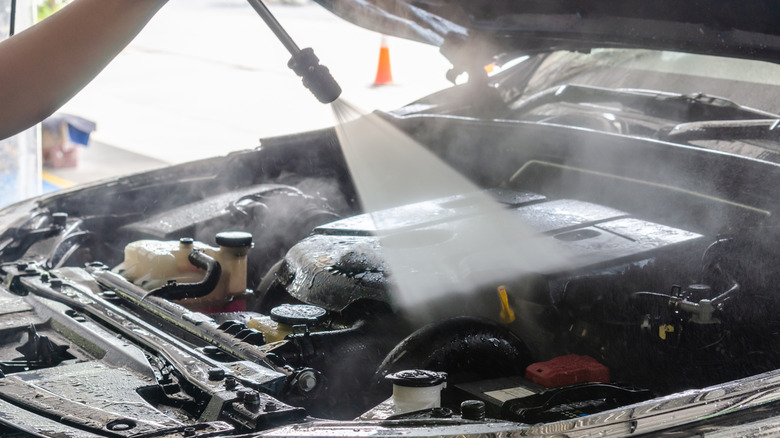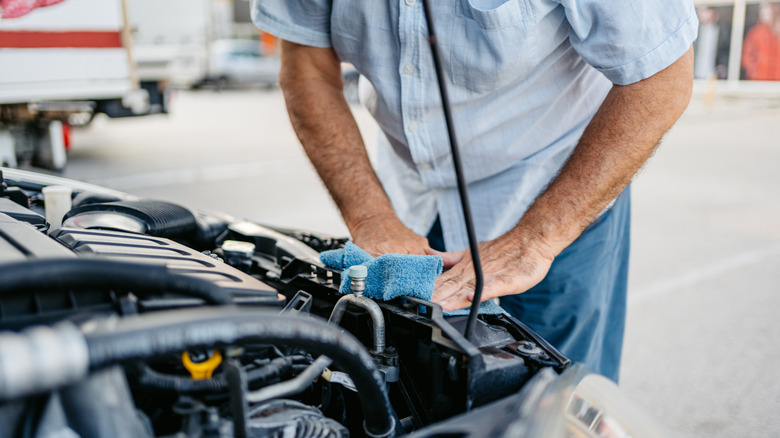Is It Safe To Hose Down Your Car's Engine Bay?
We may receive a commission on purchases made from links.
While cleaning your car's engine is important, hosing it down might be going too far. In essence, cleaning your car's engine does not require intense water pressure, such as using a pressure washer or garden hose. It's relatively safe for car engines to get wet, but dousing the engine bay with a strong water current or letting moisture dwell on the many sensitive parts of the engine and its surroundings is a big no-no, no matter if you have an old jalopy or a more modern steed.
The reason is that electricity and water are incompatible, and it so happens that a modern engine requires a multitude of sensitive electronics to operate correctly. Parts such as the alternator, ignition coils, spark plugs, ECUs, air intakes, the 12V battery, and distributor (if applicable) can malfunction due to excessive water exposure or short out unexpectedly, causing starting issues, unstable idling, engine misfires, electrical faults, or a no-start condition after washing. It might even cause the check engine light to illuminate.
So, is it safe to hose down your car's engine bay? Yes, but only after performing a few necessary precautions. Covering sensitive electronics with a plastic bag is a good start, and wrapping items like the alternator, fuse boxes, and electronic control units will hopefully prevent the engine from shorting out. Another tip is to use low water pressure and avoid mimicking the Niagara Falls when hosing the engine bay to prevent flooding or soaking the components in water.
Bring out the degreaser and cleaning wipes
There's a more straightforward and fail-safe way to clean your car's engine without hosing it down. Whether your goal is to remove gunk to find the source of oil leaks or to spruce up one of the most neglected areas of your ride, you can make it sparkling clean using an engine spray degreaser and some good old cleaning wipes or baby wipes. The first step is to remove larger chunks of dirt from the engine bay, such as dried leaves and other debris. You can remove them by hand or use a vacuum to suck out all loose dirt faster and more effectively.
The next step is to remove oil, stains, and gunk using an engine degreaser, such as the CRC Heavy Duty Pro Strength Degreaser or 3D Orange Citrus-Based Cleaner. Those products not only make quick work of grease, grime, and dark oil stains, but they also don't require rinsing with water after application. Spray the solution directly over the affected surface and wipe it off with an old cotton rag or baby wipes, and move on to the next surface. This method does not require a hose, a strong water connection, or a pressure washer, and it eliminates the risks of damaging or shorting out the engine's many electronic components.
What about the parts that are not clogged with gunk or grime but are still dirty? Grab a microfiber towel, dip it in soapy water (all-purpose cleaner dissolved in water is good), wring out the excess, and use it to wipe clean. You can use a detailing brush, like this set of four boar bristle detailing brushes, for hard-to-reach areas. Grab a spray bottle filled with soapy water, spray over the affected area, agitate with a brush, and wipe dry with a microfiber towel. Repeat until all areas are clean. You don't need to clean the engine as much as you need to clean the interior and exterior of your ride, but a decent-looking engine bay works wonders if you do a lot of tinkering under the hood.

